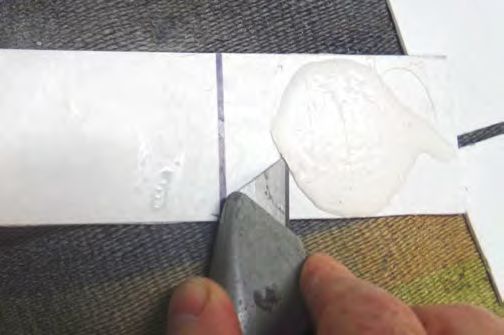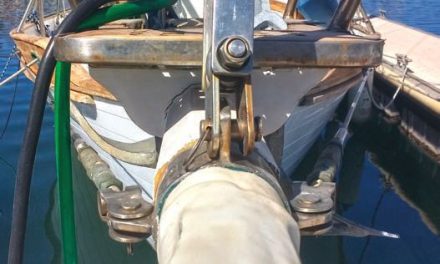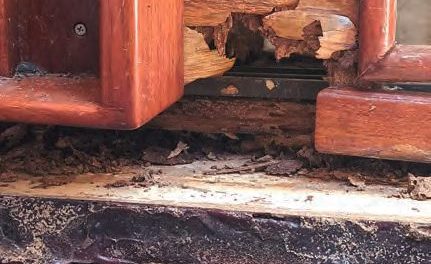The right products and technique are key to separating those stubbornly cemented parts
Issue 151: July/Aug 2023
I’ve tried solvents for removing sealants, but unless they are aggressive enough to melt gelcoat, they have little effect on polyurethane or silicone. There is always the pry-and-scrape method, but the first can remove chunks of gelcoat and the latter is sure to scratch.
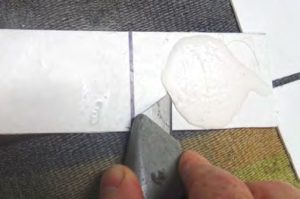
Drew slides a blade along the bond line. It’s critical to cut as close to the line and as deeply as possible. Soak with DeBond and wait 10 to 20 minutes, repeating as needed.
Polyurethane sealants adhere tenaciously, with 3M 5200 leading the pack. Referred to by some as the devil’s glue, 3M 5200 is better classified as a permanent adhesive than as a sealant, and it does not like to let go. It is too stiff to make a good sealant and involves too much of a fight to remove, so it’s better to think of it as a flexible epoxy and only use it when the items don’t move and won’t be coming apart in the next 20 years. Other polyurethanes, including 3M 4200 and Sikaflex-291, are more flexible and less tenacious, but if there is a large bond area, you still won’t pry large surfaces apart without collateral damage. You need to weaken their grip.
Silicone is not that strong, so separating the joined parts is usually not horrible. But it’s nearly impossible to remove all the residue. You scrub, and use solvents, and scrub some more, but the silicone remains in the pores and the surface still feels slippery. Nothing will bond to it, not even more silicone. You need to weaken the bond so you can get it out of the pores.
Getting the Remover in There
No matter which solvent or remover you choose, it won’t work unless you get it into the bond area. This means taking a razor knife or wire and slitting right along one of the edges, in the bond area. Soak the slit, work the solvent in with another pass of the knife or wire, and then wait 10 to 15 minutes. The chemistry takes some time. Then slit deeper, rewet, and repeat. Patience is required.
Under the Wire
Leader wire from the local bait and tackle store works better than stainless or monel rigging wire. Create a handle on each end by twisting tightly around a large dowel or screwdriver shaft. In combination with a moderately aggressive solvent, like xylene, or one of the removers mentioned below, work the wire back and forth between the deck and the hardware like a saw. Work slowly, giving the solvent a chance to work. Pause, rewet, and repeat.
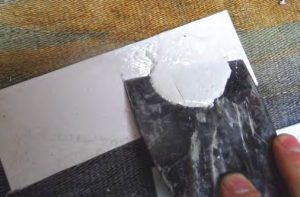
3M 4200 adhesive sealant peels off easily and cleanly after slitting the bond line and soaking for 20 minutes with DeBond Marine Formula.
Testing
I had some old hatches that were due for new lenses, so I tried a variety of solvents and removers to see what worked on the factory Dow 795 silicone. Acetone, methyl ethyl ketone (MEK), xylene, naphtha, ethylene glycol monomethyl ether (EGME), D-limonene, and glycol ethers. Nothing. I tried Goo Gone, Un-hesive, and Lift Off. Not much. I also had a deck hatch that needed resealing, but it was bound to the deck with 3M 5200 from the factory and was not coming off without pulling the skin right off the core (the bond of polyurethanes is generally stronger than the bond between the fiberglass skins and the foam or balsa core). I tried the same solvents, to no avail. Then I found three winners.
DeBond Marine Formula for Polyurethanes
My first attempt was a failure. I applied the magic juice, waited, and tried scraping. No deal. Then I got smart and called the factory. They instructed me to score neatly along the deckside bond, first with a razor, and then with a wire. Within 30 minutes, most of that time spent doing other things while the product worked, the bond was substantially weakened. I then worked my way around with a pair of small drywall knives and the hatch came right out, with no complaint or damage. Cleanup time was also reduced, since the remaining adhesive came off with a wire brush, after a 20-minute soak with DeBond.
Re-Mov and BoatLIFE Release for Silicone
I ran a box cutter down the seam between the sealant and the aluminum frame, being careful not to gouge the anodizing, and then soaked the slit with Re-Mov Silicone & Adhesive Remover. After 15 minutes, the lens popped right out, no tools required. I repeated the same process on the remaining silicone from the inside. I then sprayed the scattered residue, worked it in with a wire brush, then brushed it all off 15 minutes later. After a quick scrub and a rinse with water (or a wipe with a wet rag) to remove debris, the hatch was ready for the replacement lens to be installed, with no tedious scrubbing or sanding, and no slippery feel.
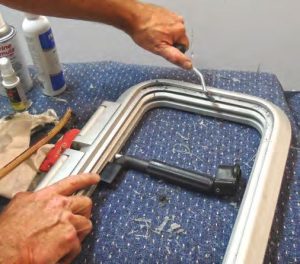
A hose pick is handy for removing the last bit of sealant.
Excited by the effectiveness, I repeated the test on gelcoat. I glued some gelcoat/fiberglass bits together with silicone, set them aside for a few months, and then separated them using Re-Mov. After a quick scrub, I bonded them with Sikaflex-291 polyurethane, allowed them to cure for a month, and then pull-tested them in shear. The silicon panels were 100% of the strength of the control panels. No more silicone residue nightmares!
BoatLIFE Release is reasonably effective on both silicone and polyurethane, but not quite as effective as the above specialty products.
Conclusions
DeBond and Re-Mov may seem a little pricey, but the time savings are considerable, the shelf life of the products is long (at least five years), and the amount required is tiny. I’ve been using a pair of 4-ounce bottles for four years, and I’m writing this because I just realized I need to order more.
To recap, a few basic tips: Be sure to score carefully. Remember that you need to get the stuff right into the bond area. And give it some time to work.
Good Old Boat Technical Editor Drew Frye draws on his training as a chemical engineer and pastimes of climbing and sailing to solve boat problems. He cruises Chesapeake Bay and the mid- Atlantic coast in his Corsair F-24 trimaran, Fast and Furry-ous, using its shoal draft to venture into less-explored waters. He is most recently author of Rigging Modern Anchors (2018, Seaworthy Publications).
Thank you to Sailrite Enterprises, Inc., for providing free access to back issues of Good Old Boat through intellectual property rights. Sailrite.com

